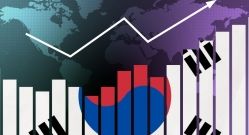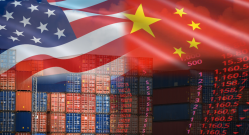
World – Macro-economic Scenario 2023-2024 : an unprecedented reversal
The scenario spins on, in the shadow of the Russia-Ukraine war. A war that is affecting not only the countries close to its epicentre, but also those farther off, through its immediate impacts such as higher food and energy costs – and the risk of shortages.
While Russia’s economy is not on the verge of collapse, and Ukrainians are putting up an impressive fight, the most likely mid-range scenario, alas, is that the war will go on. And although a welcome surprise on negotiations did not seem possible until recently, it is more plausible now, though not to the point of becoming the preferred scenario.
The scenario spins on, in the shadow of the Russia-Ukraine war. A war that is affecting not only the countries close to its epicentre, but also those farther off, through its immediate impacts such as higher food and energy costs – and the risk of shortages. While Russia’s economy is not on the verge of collapse, and Ukrainians are putting up an impressive fight, the most likely mid-range scenario, alas, is that the war will go on. And although a welcome surprise on negotiations did not seem possible until recently, it is more plausible now, though not to the point of becoming the preferred scenario.
Inflation has taken solid hold – both demand-side and supply-side; both surging inflation and inflation that just edged up slightly due to the shock of the war in Ukraine. Monetary tightening is stinging – whether it is aggressive and almost complete, or more hesitant and limited. The powerful mainsprings of the post-Covid recovery are relaxing, and economies – at varying degrees of proximity – are getting ready to tangle with recession. It appears that a deep recession will be avoidable, but (paradoxically) thanks to the shock absorbers left over from the pandemic in the form of (still-ample) private savings and relatively resilient labour markets.
In the US, a soft landing is not out of the question. However, our scenario is leaning towards a clear slowdown in growth starting in 2022 (1.9% after 5.9% in 2021), and worsening in 2023 (0.5%), with a slight recession mid-year. Inflation is high and is not expected to cool in a hurry. The pillars that held steady growth (especially in consumption) above expectations are starting to cave in. These include (1) a tight labour market but slowing job creation; (2) high growth in nominal wages but loss of purchasing power that calls for dipping into savings built up during the pandemic and using credit-card debt; (3) business surveys trending down; and (4) a downturn in residential and non-residential investment. Still, there is no sense counting on any countercyclical action by fiscal and/or monetary policies. The Fed has clearly stated it would focus on inflation at the cost of enduring a short-term recession, and the 2022 midterm elections created a power split that will be of no help with any fiscal stimulus.
In the Eurozone, the natural collapse of growth in the wake of the pandemic has been joined by the new, longer-term shock of the war in Ukraine. The shocks are coming in rapid succession, with the tracks of the past (temporary) shock overlaid by the effects of the new (more permanent) shock, and they have made the economic cycle harder to read. What are we inheriting from the pandemic? A still-solid labour market; a savings surplus that is substantial, but that has already been tapped by the lowest-income households; and inflation that we were hoping was temporary. With the debate still open as to the exact nature of inflation and how much blame to assign supply or demand, there is no denying that supply chain tensions are easing and a moderation of global inflation is spreading, but the second-round effects are visible. Energy price increases are clearly being passed on through production costs, even before any price-wage loop is singled out as the cause. What has the war in Ukraine brought us? Higher prices on energy imports which, over the first nine months of 2022 compared to the same period in 2021, add up to 4.3ppt of GDP. The dynamic effects of worsening terms of trade, inflation and lost competitiveness on export volumes and market shares will gradually spread, adding to this toll. And so, our scenario is of a marked deceleration in growth (0.1% in 2023 after 3.4% in 2022) as well as a lower growth rate for the long term, below potential growth which has itself weakened.
Finally, in China, while domestic demand has seized up and growth might not exceed 3% in 2022 (far from the initial forecast of “about 5.5%”), the reversal of the zero-Covid policy was embraced by observers. Their objection will be that it has yet to be formally enacted by the authorities. They will also specify that predicted acceleration of growth to around 5% in 2023, with a net external contribution of zero at best, and investment still hobbled by restructuring in the real estate sector, presumes that the government can manage to create enough of a confidence shock to free up some precautionary savings and stimulate consumption.
In terms of monetary policy, fighting inflation is still the top priority. Still, no matter how quickly economies are heading toward a recession, central banks are not finished with inflation. They will not risk putting down their guard too soon, especially since core inflation could turn out to be more resilient than anticipated. The ‘pivot’ the markets are hoping for is less likely to usher in a rapid decline than a pause, one which will come with some quantitative tightening. In the US, after aggressive rate hikes in 2022 totalling 425bp and bringing the target range to 4.25-4.50%, the Fed indicated that it intended to slow down the pace of hikes but clarified that tightening had not come to an end. It is expected to continue during Q123 and bring the Fed funds target up to 5.00-5.25%. Inflation’s long-term return to the 2% goal is a precondition for easing, which means it would not come before 2024. In the Eurozone, the ECB also committed to the path of monetary tightening and raised its deposit rate, moving from extremely accommodating to a restrictive threshold. After being fairly aggressive, the pace of increases is likely to slow and we expect the terminal rate to be reached in March 2023, with a deposit rate below 3%. But alongside higher rates, there will be a change in TLTRO terms prompting banks to prepay these loans. This could be the most powerful channel in terms of monetary tightening. And lastly, the start of quantitative tightening in 2023 will complete the scheme.
Inflation has yet to surrender, monetary policies are set on combating it, and the recession is in focus. These are the key ingredients in the interest rate scenario. The recovery in long-term rates is still attached to an at-best mediocre and perhaps even outright weak growth forecast. This is causing a modulated curve inversion based on the maturity of the economic and monetary cycle: full-on in the US, but moderate in Germany. As such, our scenario is calling for US 2Y and 10Y sovereign rates at 4.90% and 4.00%, respectively, at the end of 2023, while in Germany they are expected to be 3.10% and 2.60%.
And finally, after being buoyed by risk aversion, turbocharged growth and early & forceful monetary tightening in the US, the USD’s stellar run is certainly over. Indeed, the USD is expected to lose some ground in 2023, due to several factors: (1) recession (even a mild one) and a pause in monetary tightening in the US; (2) aggravated US external imbalances; (3) an overvalued USD; (4) the size of short positions; and (5) possible interventions on the FX market intended to weaken the USD.
Consult our publication World – Macro-economic Scenario 2023-2024 : an unprecedented reversal, 19 December 2022












